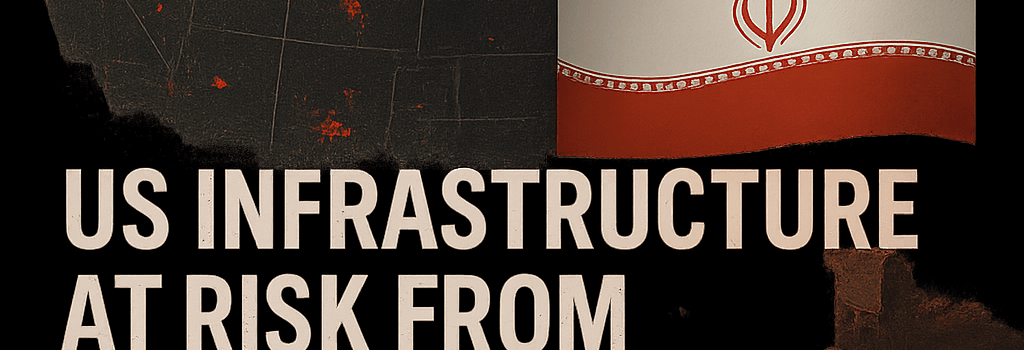US Infrastructure at Risk from Potential Iranian Cyber Attacks

July 1, 2025 – Federal cybersecurity agencies have issued a joint advisory warning that Iran-affiliated threat actors are actively targeting Industrial Control Systems (ICS) in the United States. These attacks, likely in retaliation to recent US and Israeli military operations, focus primarily on water and wastewater treatment plants, dams, and other elements of the national critical infrastructure.
Background: Geopolitical Drivers and Historical Precedent
In the aftermath of escalating tensions in the Middle East, Iranian Islamic Revolutionary Guard Corps (IRGC)–linked cyber units have demonstrated a growing capability to infiltrate and disrupt ICS environments. Between November 2023 and January 2024, security agencies confirmed that at least 75 programmable-logic controllers (PLCs) and human-machine interfaces (HMIs) were compromised globally, including 34 devices in US water treatment facilities.
Key Motivations
- Retaliation for US and Israeli military strikes in the region.
- Demonstration of asymmetric cyber capabilities against high-impact targets.
- Psychological operations aimed at undermining public confidence in essential services.
Technical Deep Dive: PLC and HMI Vulnerabilities
PLCs and HMIs serve as the backbone of process automation in critical infrastructure. Common vulnerabilities include:
- Default Credentials: Many devices ship with admin/admin or no password at all, allowing unauthenticated access.
- Lack of Network Segmentation: Exposed ICS equipment often resides on flat networks without proper VLANs or firewalls.
- Insecure Protocols: Legacy protocols such as Modbus TCP, DNP3, and CIP lack built-in encryption and authentication.
Once inside, attackers can leverage Mitre ATT&CK techniques such as T0889: Industrial Control Systems Manipulation to alter process parameters, disable safety interlocks, or render devices unresponsive to legitimate operators.
Internet-Exposed Devices: Latest Censys Findings
Security firm Censys conducted large-scale internet scans from January to June 2025, identifying dramatic increases in exposed ICS and building automation devices:
- Tridium Niagara Framework: +9% (from 39,371 to 43,167 exposed systems)
- Red Lion Controllers: +7% (from 2,453 to 2,639)
- Unitronics Vision Series: +4% (from 1,622 to 1,697)
- Orpak SiteOmat: –24% (successful remediation noted in some sectors)
These devices often reside in public IP ranges with open TCP ports (502 for Modbus, 44818 for EtherNet/IP), and many still use factory-default user accounts that threat actors can exploit within seconds.
Expert Opinions on Hardening Measures
“Any device accessible from the Internet without multi-factor authentication and encrypted communications is a ticking time bomb,” said Dr. Elena Martínez, ICS cybersecurity lead at SANS Institute. “Defenders must adopt a zero-trust architecture, enforce strict network segmentation, and deploy deep-packet inspection at the network edge.”
- Strong Password Policies – Enforce complex credentials and rotate them quarterly.
- Network Segmentation – Isolate ICS networks via firewalls and data diodes.
- Encrypted Protocols – Migrate to OPC UA or secure DNP3 where possible.
- Continuous Monitoring – Implement IDS/IPS solutions tuned for ICS signatures.
Regulatory and Compliance Considerations
The Cybersecurity and Infrastructure Security Agency (CISA) and the National Institute of Standards and Technology (NIST) provide frameworks—NIST SP 800-82 Rev. 3—to guide ICS security. Compliance with the Emergency Preparedness and Response (EPR) security directive is now mandatory for water sector operators, requiring documented incident response plans and regular tabletop exercises.
Future Threat Outlook and Recommendations
Given Iran’s demonstrated cyber prowess and ongoing geopolitical frictions, US critical infrastructure remains at high risk. Agencies advise the following next steps:
- Audit all ICS devices for internet exposure and default credentials.
- Deploy multi-factor authentication and VPN gateways for remote access.
- Engage in threat intelligence sharing through ISACs (Information Sharing and Analysis Centers).
- Schedule quarterly penetration tests and red-team exercises focused on ICS environments.
By adopting a defense-in-depth strategy—combining technical controls, process improvements, and personnel training—utilities can significantly reduce their attack surface and resilience against sophisticated nation-state adversaries.